 The TRS-80 Model 100.
The TRS-80 Model 100.
The TRS-80 Model 100 and the NEC 8201A/8300 are examples of a series of battery powered powertable computers based on a common design by Kyocera. These were the first truly portable computers, and were released in 1983. The NEC machines contained a BASIC interpreter, text editor and telecom application. The TRS-80 Model 100 added an address boock and scheduler.
The ultimate in low power, these machines run for days on a set of 4 AA batteries. With no hard drive to spin up (everything is contained in non-volatile RAM), they could be powered up and down at a moments notice. Because of these features, these machines are still in demand for certain environments and there are a few companies in the business of finding and refurbishing them for this market.
I used my Model 100 mainly as a text editor, which allowed me to work on source files when I was away from my office. Even though it was tiny by the days standards, it had a full sized keyboard and was actually quite easy to work on. The built in telecom program and RS-232 port allowed for easy transfer of text files back and forth to my main system. I occationally used the internal 300 bps modem to remotely access my other machines.
The NEC 8201A & 8300 were donated by Don Mitchell. Model-100s were donated by Markus Wandel and Norman McIvor
Click any photo to view a large high-resolution image.
 Here we see the full sized DB-25 RS-232 port, the printer connector, as well
as the interface jacks for Phone and Cassette I/O.
Here we see the full sized DB-25 RS-232 port, the printer connector, as well
as the interface jacks for Phone and Cassette I/O.
 A closeup of the screen in action.
A closeup of the screen in action.
 The Model 100 came with a nice carrying case, and a small summary manual
which would fit in the case with the unit.
The Model 100 came with a nice carrying case, and a small summary manual
which would fit in the case with the unit.
 Here we see the main logic board. Note the "Stacked" memory chip near
the bottom center. There were 4 2k devices in a single 8k carrier (2 top, 2 bottom).
Beside it you will see an aftermarket 8k device on an adapter board which uses diodes
to generate a single select for the 8k device.
Here we see the main logic board. Note the "Stacked" memory chip near
the bottom center. There were 4 2k devices in a single 8k carrier (2 top, 2 bottom).
Beside it you will see an aftermarket 8k device on an adapter board which uses diodes
to generate a single select for the 8k device.
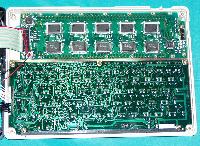 This is the inside of the top half, showing the LCD controller and the
keyboard matrix.
This is the inside of the top half, showing the LCD controller and the
keyboard matrix.
 The back of the unit showing the information label.
The back of the unit showing the information label.
 This is a Model 200, featuring a larger fold-down screen, better cursor keys,
more RAM, and additional internal software. Released in 1984, the large screen
was a big improvement, however it never gained the popularity of the original
Model 100.
This is a Model 200, featuring a larger fold-down screen, better cursor keys,
more RAM, and additional internal software. Released in 1984, the large screen
was a big improvement, however it never gained the popularity of the original
Model 100.
Views: Top, Back, Left-Side, Right-Side, Inside, Label
 This is a Model 102. Released in 1985, this was a slight improvement
on the Model-100, it contained a minor ROM bug fix, and was slightly
thinner and lighter.
This is a Model 102. Released in 1985, this was a slight improvement
on the Model-100, it contained a minor ROM bug fix, and was slightly
thinner and lighter.
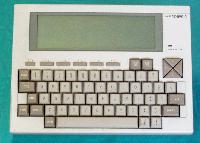 The NEC 8201A is another machine based on the same basic design as the
Model-100. Here is this machines history.
The NEC 8201A is another machine based on the same basic design as the
Model-100. Here is this machines history.
 The NEC 8300 is an upgraded 8201. It features more internal RAM and a
built in modem. This is the only model in the series not manufactured
by Kyocera - the 8300 was built by NEC (under license of Kyocera).
The NEC 8300 is an upgraded 8201. It features more internal RAM and a
built in modem. This is the only model in the series not manufactured
by Kyocera - the 8300 was built by NEC (under license of Kyocera).
 Rear view of 8201A (top) and 8300 (bottom). The covers have been
removed on the 8201A so that you can see the connectors.
Rear view of 8201A (top) and 8300 (bottom). The covers have been
removed on the 8201A so that you can see the connectors.
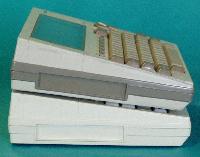 In the left side, this "flap" covers an expansion connector.
In the left side, this "flap" covers an expansion connector.
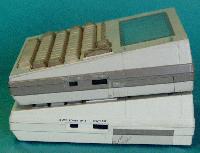 The right side has the power switch and contrast control. To the lower
right, you can see the end of the slide-out battery carrier.
The right side has the power switch and contrast control. To the lower
right, you can see the end of the slide-out battery carrier.
 Bottom view of 8201A with covers removed. Upper left is the place where
the slide-out battery carrier goes. Note the expansion ROM, and extra
RAM chips installed.
Bottom view of 8201A with covers removed. Upper left is the place where
the slide-out battery carrier goes. Note the expansion ROM, and extra
RAM chips installed.
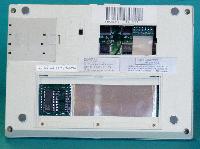 Bottom view of 8300 with covers removed. Here the slide-out battery
carrier is installed. I do not know the purpose of the compartment in
the upper right, however it has a large bus connector inside. Note that
the lower panel now provides access only to ROMs as the machine already
has the maximum ram.
Bottom view of 8300 with covers removed. Here the slide-out battery
carrier is installed. I do not know the purpose of the compartment in
the upper right, however it has a large bus connector inside. Note that
the lower panel now provides access only to ROMs as the machine already
has the maximum ram.
 A boatload of Model-100 accessories (clockwise from upper left):
A boatload of Model-100 accessories (clockwise from upper left):
Printer cable, Disk/Video interface (portable drive on top), System
carry case, Software & Cassette interface, Model 100 case, Cassette
deck case & interface cable, "Feet" to rais rear of Model-100, Power
adapter, Modem cups, Direct phone cable.
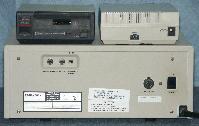 Rear of Disk/Video interface and closeup of the portable disk drive.
The DVI connects via the expansion connector on the bottom of the Model-100,
the portable drive connects via an RS-232 serial cable.
Rear of Disk/Video interface and closeup of the portable disk drive.
The DVI connects via the expansion connector on the bottom of the Model-100,
the portable drive connects via an RS-232 serial cable.